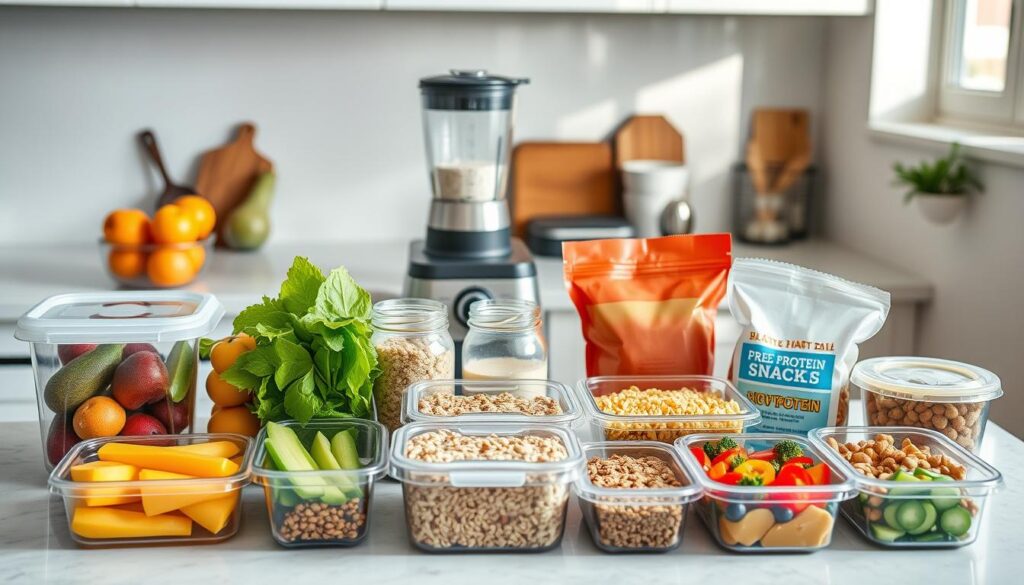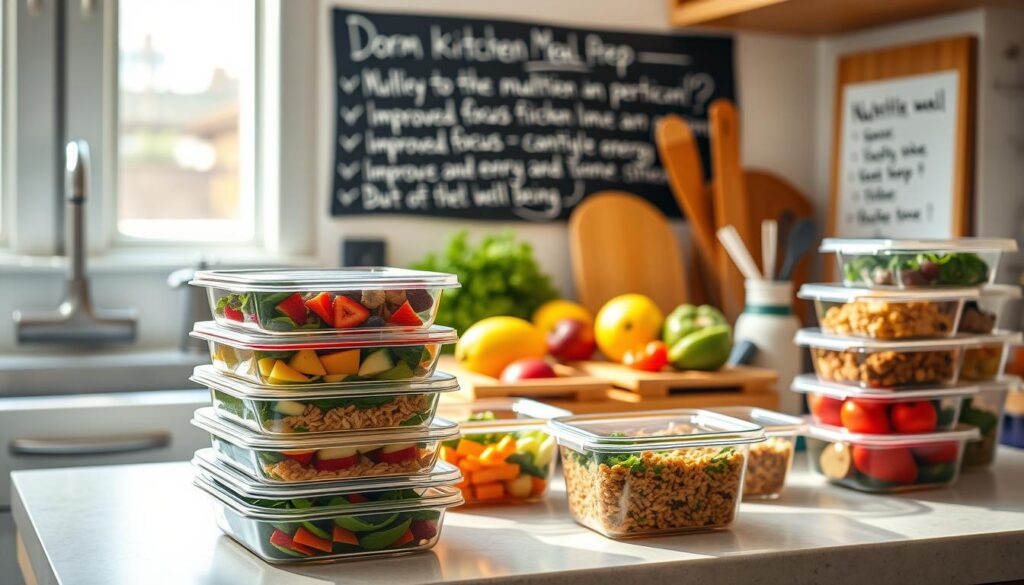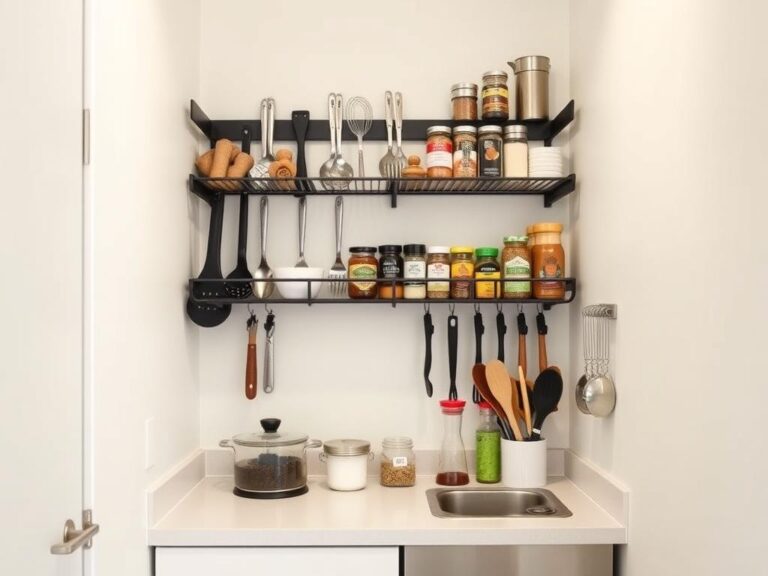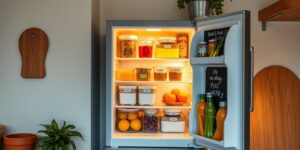Dorm kitchen meal prep tips with zero cooking required
Discover easy Dorm kitchen meal prep ideas that require zero cooking. Get healthy meal inspiration for your dorm life.
College life brings endless opportunities – and endless challenges for eating well. Between packed schedules and limited cooking tools, many students struggle to maintain balanced diets. But here’s the good news: you don’t need a stove or chef-level skills to create tasty, nourishing meals.

This guide focuses on smart strategies for crafting meals using basic appliances like microwaves and compact fridges. We’ll explore how to assemble satisfying dishes without turning on a burner – perfect for tight budgets and tighter schedules. Whether you’re rushing to class or pulling an all-nighter, these solutions keep you fueled.
The best part? These approaches require minimal cleanup and maximize nutrition. From protein-packed snacks to fridge-friendly salads, you’ll discover how to work smarter, not harder in your shared living space. Let’s transform how you think about food preparation in student housing.
Key Takeaways
- Create balanced meals using only microwaves and mini-refrigerators
- Save money with budget-friendly ingredient combinations
- Reduce cleanup time with no-cook assembly methods
- Maximize limited storage space with smart organization
- Maintain energy levels with protein-rich snacks
Introduction: Embracing No-Cook Dorm Meals
Academic demands often push nutrition to the bottom of a student’s priority list. Between lectures, group projects, and extracurriculars, time-consuming cooking feels impossible. Shared spaces and tight budgets add layers of complexity to food choices, leaving many relying on vending machines or skipping meals entirely.
No-cook strategies flip this script by emphasizing assembly over cooking. Fresh produce, canned beans, and pre-cooked grains become heroes in this approach. These ingredients require no heat, minimal tools, and transform into balanced plates faster than delivery apps can arrive.
Students discover unexpected benefits beyond convenience. Pre-portioned ingredients reduce waste, while reusable containers maximize limited fridge space. This method also sidesteps the need for pricey kitchen gadgets – a major win for those navigating campus life on a shoestring budget.
What Else Would You Like to Know?
Choose below:
Adopting these habits creates ripple effects. Consistent energy levels improve focus during exams, and smarter spending leaves room for occasional treats. It’s not about perfection, but finding sustainable ways to fuel the college journey.
Dorm kitchen meal prep: Benefits for College Life
Balanced nutrition often gets lost in the whirlwind of campus routines. Strategic food preparation solves this by turning chaotic eating habits into structured, stress-free systems. Students who plan meals in advance report 63% less decision fatigue compared to peers relying on spontaneous choices, according to a recent campus nutrition survey.

Financial savings add up quickly when buying ingredients in bulk. A week’s worth of prepped sandwiches and salads costs roughly half the price of daily cafeteria visits. This approach also minimizes impulse purchases at convenience stores – a common budget drain for busy scholars.
Time management transforms with batch preparation. Dedicate two hours on Sunday to chopping veggies and assembling jars, then reclaim 10+ weekly hours normally spent waiting in takeout lines. These extra moments become golden opportunities for study groups or self-care.
Health improvements follow naturally when controlling portion sizes and ingredients. Swap mystery cafeteria sauces for homemade yogurt dressings, or trade sugary snacks for protein-packed trail mixes. Consistent energy levels from balanced meals sharpen focus during lectures and late-night study marathons.
The ultimate perk? Having ready-to-eat options eliminates the “hangry” panic between classes. No more skipping meals or settling for vending machine junk – just grab a pre-packed container and keep conquering your day.
Essential Tools & Storage Solutions for Dorm Kitchens
Smart organization transforms cramped spaces into functional food stations. The right equipment turns limited areas into efficient hubs for assembling nutritious dishes. Focus on versatile items that serve multiple purposes while fitting in tight quarters.
Space-Saving Essentials
A reliable microwave becomes your best ally for heating prepped items or steaming veggies in minutes. Pair it with a mini-fridge featuring separate compartments – ideal for storing fresh produce and ready-to-eat components. Opt for nesting bowls and collapsible measuring cups that tuck away neatly.
Essential utensils should include:
- A sharp paring knife for slicing fruits
- Reusable silicone lids instead of bulky containers
- A cutting board that doubles as a serving tray
Smart Storage Systems
Invest in stackable containers with leak-proof seals – they prevent spills and maximize fridge real estate. Glass versions withstand repeated use, while BPA-free plastic works for lighter needs. Portion-controlled dividers help manage servings without guesswork.
Mini freezers unlock game-changing advantages. Store frozen berries for smoothies or bulk-bought proteins to cut costs. Research shows students using these appliances reduce food waste by 40% compared to those relying solely on shared refrigeration.
Label everything with dates using washable markers. Rotate older items to the front to maintain freshness and avoid mystery leftovers. With these strategies, even the smallest spaces become powerhouses for efficient eating.
Planning Your Zero-Cook Meal Strategy
Smart planning turns chaotic eating into a streamlined system. Start by mapping your week’s commitments – classes, study sessions, and social events. This awareness helps match meals to your energy needs while minimizing last-minute food decisions.
Building Your Blueprint
Create balanced menus using three core elements: proteins, fresh produce, and whole grains. Rotate ingredients across days to prevent boredom. For example, use grilled chicken in wraps Monday and toss it into Wednesday’s salad.
| Day | Breakfast | Lunch |
|---|---|---|
| Monday | Greek yogurt + berries | Hummus veggie wrap |
| Wednesday | Overnight oats | Quinoa bowl |
| Friday | Peanut butter toast | Chicken Caesar jar |
Smart Scheduling
Block 90 minutes weekly for ingredient prep – Sundays work best for most students. Wash greens, portion snacks, and assemble grab-and-go containers. This upfront effort saves 10+ hours during busy weekdays.
Budget tips:
- Buy frozen fruits for smoothies
- Use canned beans for protein boosts
- Shop seasonal vegetables
Keep a running grocery list on your phone. Update it when supplies run low to avoid multiple store trips. With this strategy, you’ll spend less money and mental energy on daily meals.
Quick Breakfast Ideas for Students
Morning routines demand speed and nutrition. These no-fuss breakfast solutions deliver both, requiring just minutes to assemble. Perfect for rushed scholars needing brain fuel before lectures.
Overnight Oats and Chia Pudding
Combine rolled oats with milk in a 1:1 ratio, then refrigerate overnight. Wake up to creamy, ready-to-eat goodness packed with fiber. Chia seeds transform similarly – mix 3 tablespoons with 1 cup liquid for pudding texture.
Boost protein with these add-ins:
- Greek yogurt swirls
- Almond butter drizzle
- Hemp seed sprinkles
Try these flavor combos:
| Base | Mix-Ins | Toppings |
|---|---|---|
| Almond milk oats | Blueberries | Walnuts |
| Coconut chia | Mango chunks | Toasted coconut |
Avocado Toast Variations
Upgrade basic toast with smashed avocado and smart seasoning. Choose dense breads like rye or sprouted grain for lasting energy. Spread mixture thickly, then customize:
- Everything bagel seasoning + radish slices
- Chili flakes + fried egg
- Sunflower seeds + balsamic glaze
Store unripe avocados in dark spaces – they’ll last 4-5 days. Sprinkle lemon juice on leftovers to prevent browning. No fresh avocados? Swap in pre-made guacamole packs for similar creaminess.
Light Lunches: No-Cook Salads and Wraps
Midday meals don’t need to sacrifice flavor for convenience. Build protein-packed salads using chickpeas or canned beans as your base – these ingredients stay fresh for days and require zero cooking. Mediterranean chickpea combinations work particularly well, mixing diced cucumbers, cherry tomatoes, and feta cheese with lemon-olive oil dressing.
For a tuna-like twist without fish, try mashed chickpeas with mustard and dill. This plant-based alternative delivers the same creamy texture and zesty kick. Serve it in lettuce wraps or whole-grain tortillas for portable lunch solutions that survive backpack transport.
Keep ingredients crisp with smart storage:
- Store dressings in separate containers
- Layer hearty veggies at the bottom of jars
- Add nuts or croutons just before eating
Mix-and-match components throughout the week using this template:
| Base | Protein | Toppings |
|---|---|---|
| Quinoa | Hard-boiled eggs | Bell peppers |
| Spinach | Canned chicken | Sunflower seeds |
Rotate dressings between tahini sauce and balsamic vinaigrette to prevent flavor fatigue. These no-fuss meals prove eating well between classes requires more creativity than cooking skill.
Creative Snack Options for Dorm Life
Smart snacking acts as a secret weapon for maintaining energy during back-to-back classes. Nutrient-dense options prevent afternoon crashes while fitting seamlessly into student schedules. The key lies in combining convenience with ingredients that deliver lasting fuel.
Protein-Packed Energy Solutions
Homemade bars outperform store-bought versions in cost and nutrition. A basic recipe combines oats, nut butter, and honey – no baking required. Customize with add-ins like dark chocolate chips or dried cranberries for variety.
Consider these wallet-friendly comparisons:
| Store-Bought | Homemade | Savings |
|---|---|---|
| $2.50 per bar | $0.75 per bar | 70% cheaper |
| 12g protein | 18g protein | 50% more |
Trail mixes offer portable crunch without prep work. Combine raw almonds, pumpkin seeds, and unsweetened coconut flakes in reusable bags. For sweet cravings, mix in cacao nibs or freeze-dried strawberries.
Storage tips maximize freshness:
- Use airtight containers for dry mixes
- Freeze energy bites for 3-month shelf life
- Portion snacks into single servings
Rotate flavors weekly to keep things interesting. Try peanut butter-cinnamon bars one week and almond-apricot clusters the next. These smart swaps help avoid vending machine traps while supporting academic performance.
Microwave Magic: Meals That Only Need a Quick Heat
Your microwave holds untapped potential for creating hearty dishes quickly. This appliance becomes a culinary ally when armed with the right techniques. Discover how to craft satisfying meals that go beyond reheating leftovers.
Microwave Tuna Casserole
This protein-packed recipe transforms pantry staples into comfort food. Combine canned tuna, cream of mushroom soup, and frozen peas in a microwave-safe bowl. Heat in 90-second bursts, stirring between cycles. Top with crushed crackers for crunch.
Key tips for success:
- Use 50% power for even cooking
- Add milk gradually to control thickness
- Let stand 2 minutes before serving
Quick Rice and Chicken Options
Master microwave rice with this foolproof method. Rinse 1 cup grains, add 2 cups water, and cover tightly. Cook 12 minutes at high power. Fluff with fork – perfect base for chicken bowls.
Pair with pre-cooked rotisserie chicken for multiple meals:
- Asian stir-fry with frozen veggies
- Tex-Mex burritos using canned beans
- Lemon-herb salad with mixed greens
Store components separately in airtight containers for 4-day freshness. These recipes prove limited appliances can’t limit flavor.
FAQ
How can I add protein to no-cook meals without a stove?
What are fast breakfast ideas for early classes?
Can I keep meals fresh without a full-size fridge?
Are microwave-safe meals actually flavorful?
What’s a budget-friendly lunch option with no cooking?
How do I avoid snack boredom between classes?
Can I make meals ahead without losing texture?
Tiny Kitchen, Big Ideas: Organizing Your Small Student Kitchen
» See exclusive tips for your home








